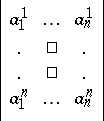Kronecker symbol
The number  defined by
defined by
 |
 . When
. When  , the Kronecker symbol
, the Kronecker symbol  has
has  components, and the matrix
components, and the matrix  is the unit matrix. The Kronecker symbol was first used by L. Kronecker (1866).
is the unit matrix. The Kronecker symbol was first used by L. Kronecker (1866).
The Kronecker symbol may be generalized, considering instead a set of quantities  with
with  integer (upper and lower) indices,
integer (upper and lower) indices,  ,
,  , equal to
, equal to  (or
(or  ) if the sequence
) if the sequence  is an even (odd) permutation of the distinct indices
is an even (odd) permutation of the distinct indices  and zero otherwise. The numbers
and zero otherwise. The numbers  (when
(when  often denoted by
often denoted by  ) are called the components of the Kronecker symbol. An affine tensor of type
) are called the components of the Kronecker symbol. An affine tensor of type  whose components relative to some basis are equal to the components of the Kronecker symbol has the same components relative to any other basis.
whose components relative to some basis are equal to the components of the Kronecker symbol has the same components relative to any other basis.
The Kronecker symbol is convenient in various problems of tensor calculus. For example, the determinant
 |
is equal to the sum
 |
where the summation is performed over all  permutations of the numbers
permutations of the numbers  . The alternant of the tensor
. The alternant of the tensor  is given by
is given by
 |
References
| [1] | L. Kronecker, "Vorlesungen über die Theorie der Determinanten" , Leipzig (1903) |
Kronecker symbol. Encyclopedia of Mathematics. URL: http://encyclopediaofmath.org/index.php?title=Kronecker_symbol&oldid=18809